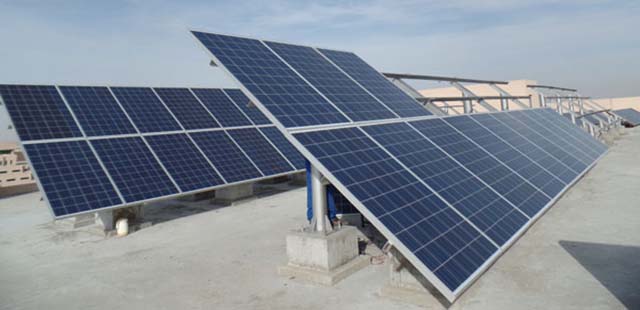Three Hundred sunny days with abundant free solar irradiation to generate solar power and strong support of the Government of Afghanistan; make the country an attractive destination for setting up photovoltaic solar power projects. The country currently uses large quantities of diesel for power generation, which can be significantly reduced by setting up MW size solar power stations in various provinces of Afghanistan.
Solar power is not new to Afghanistan. It is widespread, albeit on a much smaller scale in the form of rooftop installations. Rooftops have already penetrated into vast number of household and commercial establishments. Solar power has become the lifeline of these users in many provinces and towns. The largest solar power installation at a single location in Afghanistan is Bamyan. This complex has multiple solar power generating plants having an aggregate facility of 1 MW.
Government of Afghanistan and the national utility, De Afghanistan Brishna Shirkat (DABS), has taken its first initiative by planning a 10 MW solar PV power plant in Kandahar, which is envisaged to be set up as an Independent Power Plant by the private sector. The project would be awarded to the bidder who quotes the lowest tariff based on an international competitive bidding process.
Afghanistan is slowly and gradually developing into a competitive market of solar EPC services and all major components needed to construct the best in class solar PV system are available in the country, through a large number of vendors, who import the critical components from the Asian market. A number of reputed international companies are working with local solar service providers for implementation of various solar power plants in Afghanistan. Most of the key components like solar panels, grid-tied inverters, irradiation sensors, etc. are imported mainly from China and some other countries, who have experienced solar power equipment manufacturers.
The key factors that need to be considered and analyzed for implementation of best optimized solar plant are:
• Solar Irradiation at site.
• Temperature and climatic conditions.
• Design parameters of the plant.
• Solar panel and inverter efficiency.
• Module degradation in 25 years.
• Generation losses.
Some of the modern features of a solar photovoltaic plant are:
Synchronization of a Solar Plant, Utility Grid and the Consumer Load is such that the solar current is given priority to enable the injection of solar energy first priority into the system.
Even Grid failures do not interrupt the power supply through Solar Plant as the Smart Inverters are synchronized with already installed DG sets of the consumers, thus saving appreciable diesel consumption cost.
The errorless solar system reacts first in any kind of faults related to Grid by efficiently isolating itself from the whole system in fraction of a second.
All these technical advancements with 25 years of guaranteed generation bring the payback period within 4-6 years depending on the government utility tariff, power interruptions and power consumption profile of the user.
With all these technological advancements and emerging solar market competitiveness in Afghanistan, an investor/ developer/ owner can easily install and use/ supply solar power from at least 100 KW solar system, if a suitable site is available. Even a small size solar PV plant models can demonstrate to the consumers that by embracing a solar system they can manage to secure themselves against escalating power tariffs as well as helping directly in reduction of carbon footprints of the country.
Kandahar Solar Project is a 10 MW capacity Solar-Diesel-Grid hybrid power project that is being looked at as a key solution to provide interim relief to the Kandahar electricity consumers (Industrial Parks, Commercial Centres and Residential). Successful installation of Solar PV project which is proposed to be built as IPP (Independent Power Plant) will not only meet the demand of Kandahar, but also act as a model that could be replicated in the other parts of Afghanistan.
The project is being looked at as an important development as part of a larger objective of the United States Government (USG) in coordination with the Government of the Islamic Republic of Afghanistan (GIRoA) for the development of Kandahar region. The program is being implemented with the help of USAID with a consortium of companies (Phoenix, KPMG, Tractebel, RIAA LAW). The RFP is expected to be published in mid-September 2015, which will be followed by a pre-bid meetings and Roadshows. The objective will be to enable selection of suitable developer through international competitive bidding, eventually leading to most competitive tariff for power consumers in Kandahar. The selected IPP will own, operate and manage the project under a long term Power Purchase Agreement (PPA) with DABS.

